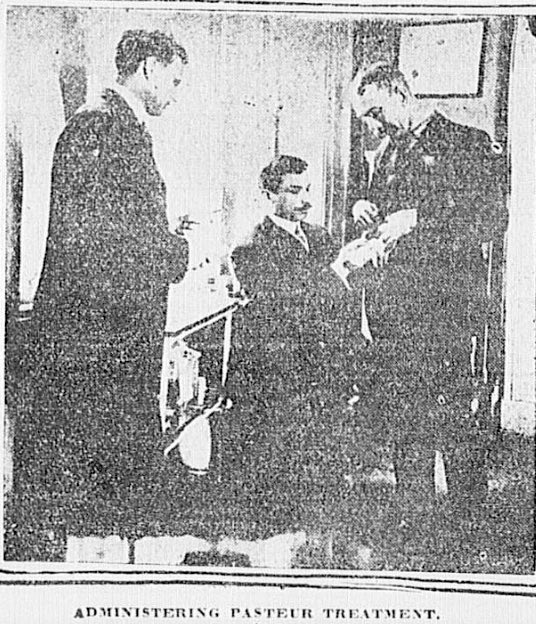
Before it became known as rabies, it was called hydrophobia (fear of water). The fear of water is one of the symptom of rabies, a viral disease that is usually transmitted from one mammal to another through saliva. Animal bites are a common way for people to get rabies. Once bitten, the victim has only a short window of opportunity to get the vaccine. If the vaccine is not received in time, the victim will almost always die. Since there has never been a sure cure for the disease, it has caused fear among people for thousands of years.

Fines In Ancient Egypt
Rabies was well known to ancient Egyptians. In some of the earliest records of the disease, there is a hieroglyph showing a man who was bitten by a dog exhibiting the signs of madness associated with rabies.
The Code of Eshnunna warned ancient Egyptians to confine dogs suspected of carrying rabies. If a person was bitten by the dog, whether that person was a slave or one of the higher classes, there were fines that needed to be paid for the victim’s pain and suffering. [SOURCES 1, 2]
Ancient Greek Preventions
Celsus, a Greek philosopher from the 2nd century, wrote about rabies. At the time, the Greeks understood that it was a disease passed on to others through “venom” or infected saliva. He recommended that people who have been bitten undergo cupping or that another person should attempt to suck the poison out of the wound, as long as that person had no mouth wounds for the “venom” to enter. The use of caustics or burning the wound were also suggested with the goal of killing off or neutralizing the virus. [SOURCE 3]
Menstrual Fluid
Naturalist Pliny the Elder offered up a strange cure for rabies in ancient Rome. According to his writings, if a person starts to exhibit signs of rabies and begins to fear liquids, one must place a strip of cloth under the victim’s cup. The cloth must be dipped in menstrual fluid before being used and it was believed that after the person drank the liquid inside the cup, he would be cured of the disease.
This was a form of sympathetic magic. Some ancient Romans believed that dogs became “mad” after tasting menstrual fluids, so in order to fight the disease menstrual fluids must be used again as a counter agent. [SOURCE 4]
Cured By The Sea
In ancient Greece, it was believed that bodies of water, such as a pond or the sea, were capable of curing people of hydrophobia. The practice called for throwing the rabid person into the water, allowing him to sink, and then pulling him out.
This practice survived into the 1800s. A book published in 1872 recounts a Belgium practice of binding and weighing down a man suffering from rabies. They took the man out to sea and plunged him several times into the salt water. When they were through and the man was revived, the man was supposedly cured and went on to live his normal life. [SOURCE 5]
Biological Weapon
Our ancient ancestors were rather devious when it came to finding new ways to kill off enemies. Aelian, a 2nd century Greek military writer, noted that a wounded enemy could be infected with rabies by using a cloth that was bitten by a mad dog. Even Leonardo de Vinci contemplated a bomb made with rabid dog saliva, tarantula venom, and other deadly ingredients.
By the 1600s, a Polish-Lithuanian artillery general, Kazimierz Siemionowicz, wrote about placing rabid dog drool into hollow clay balls and hurling these biological bombs at enemies.
In more recent times, the Soviet Union attempted to weaponized rabies in the 1960s and 1970s. [SOURCE 6]
Rabies Was A Big News Item Over A Century Ago
Every summer in the late 1800s and early 1900s, newspapers lit up with reports of rabid animals and how to avoid “mad dog” bites. The articles were sometimes informational, giving the community instructions on how to avoid getting bit, what to do if there is a rabid animal in the neighborhood, and the symptoms of rabies. Other short articles were akin to fear mongering, reporting on some pet or animal being killed for fear of it being rabid.
While rabies was more prevalent over 100 years ago than it is today, it was still considered “one of the rarest diseases.” This is probably because the rabies vaccine was developed in 1885 by Louis Pasteur. [SOURCES 7, 8]

Stray Dogs Outlawed
In 1874, before there was a rabies vaccine, New York City was having a rabies scare. The blame was placed squarely on the stray dogs of the city. While dog shelters today have quarantine processes to capture and watch over stray dogs, this was not a common practice in the late 1800s dog pounds. Animal protection societies were only just starting to form in the U.S. at this time and the regular method for getting rid of unwanted dogs was to kill them.
That is exactly what happened in NYC. Stray dogs became outlawed and were hunted down and killed for fear of rabies. The pounds were working extra hard to execute as many homeless dogs as possible. Even the police were involved and in Brooklyn an ordinance was passed “making it the duty of the police to slay at sight every loose unmuzzled dog.” [SOURCE 9]
Australia Calls For Quarantine
When news came out of an assumed rabid dog in Melbourne, the people of Australia wanted to take steps to prevent the importation of rabies. Since Australia was mostly free of the disease, they had every right to take precautions against bringing in the disease from other countries.
Their solution was simple. They wanted all dogs quarantined for six months before being released to the owner. This meant that any traveler coming into Australia had to place his or her dog into quarantine. After the six months passed, the owner would be free to claim his dog and Australians could remain free from the fear of rabies. [SOURCE 10]
Hydrophobic Skunks
Rabid skunks were a problem in Arizona during the early 1900s. In 1907, it was reported that a prospector from Tombstone was sleeping outdoors while looking for potential mining sites in the Dragoon mountains. Up came a skunk and bit the man on the nose. The prospector and his partner had to give up their search and head back to civilization. He was shipped off to Chicago to receive the rabies vaccination at the Pasteur Institute.
The newspaper article goes on to say that this wasn’t the first time this had happened. Another man had just gone to Chicago for a vaccination because of another rabid skunk bite. People had to be careful sleeping in the hills because rabid skunks had already taken lives by biting people in their sleep. [SOURCE 11]
It Is All In Your Head
It is hard to believe, but in 1906 an article appeared in a few U.S. newspapers that claimed rabies was probably an imaginary disease or a symptom of another, undiscovered disease. Some medical doctors claimed that the “[m]ental influence will not be denied” and that the less imaginative people (a.k.a. poor people) were less likely to come down with rabies as opposed to a “highly organized person” who has more time to brood over a dog bite. In other words, wealthier people with more free time were more likely to imagine themselves sick and, in turn, make themselves physically ill. [SOURCE 12]

